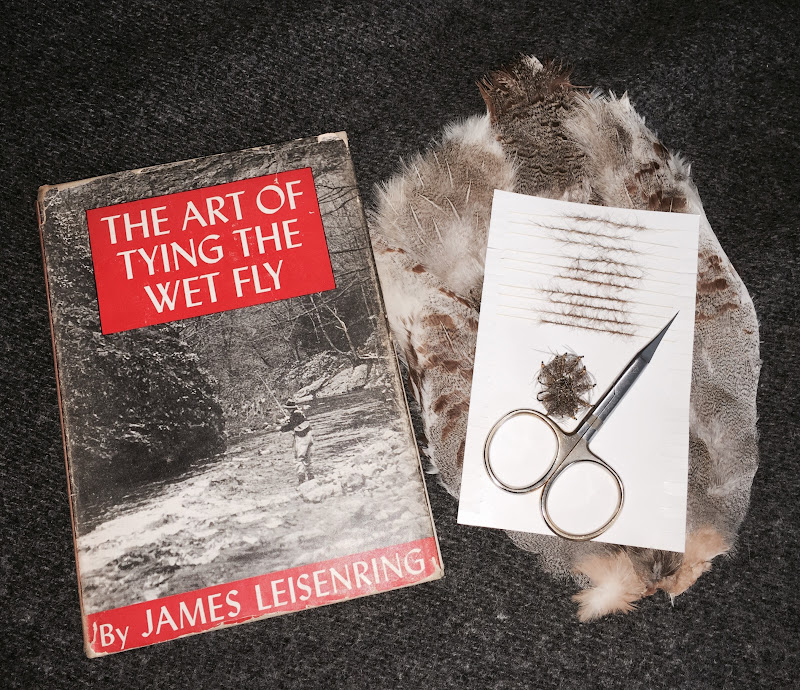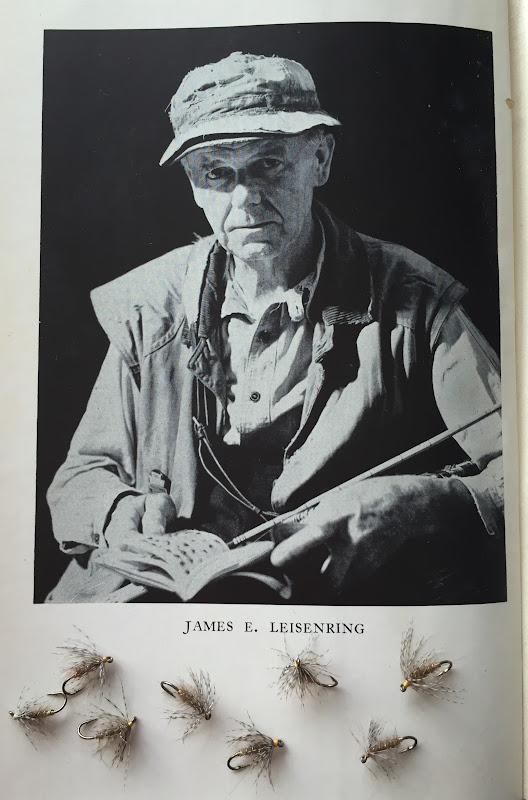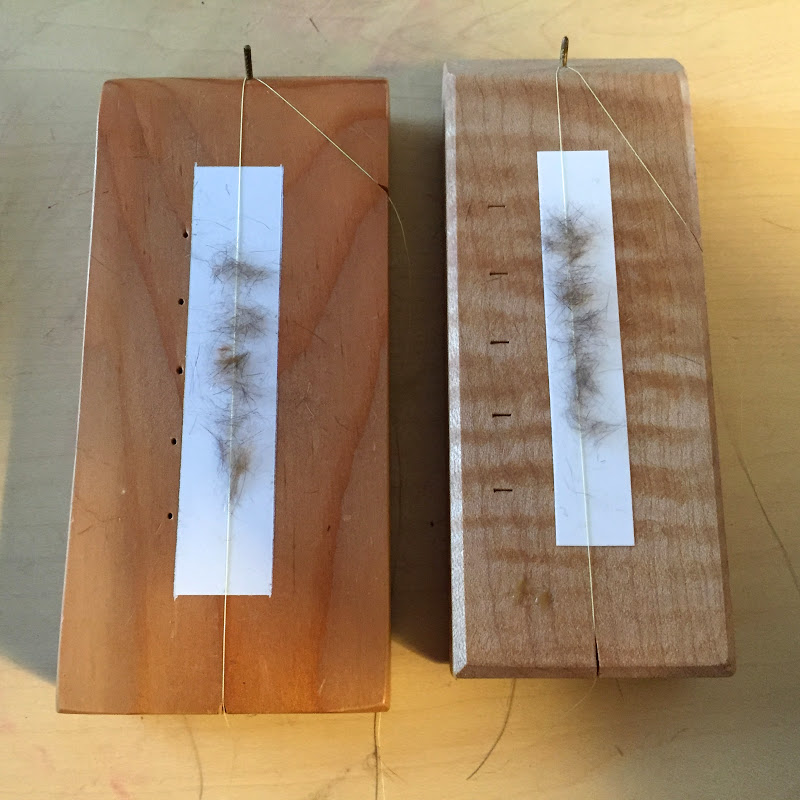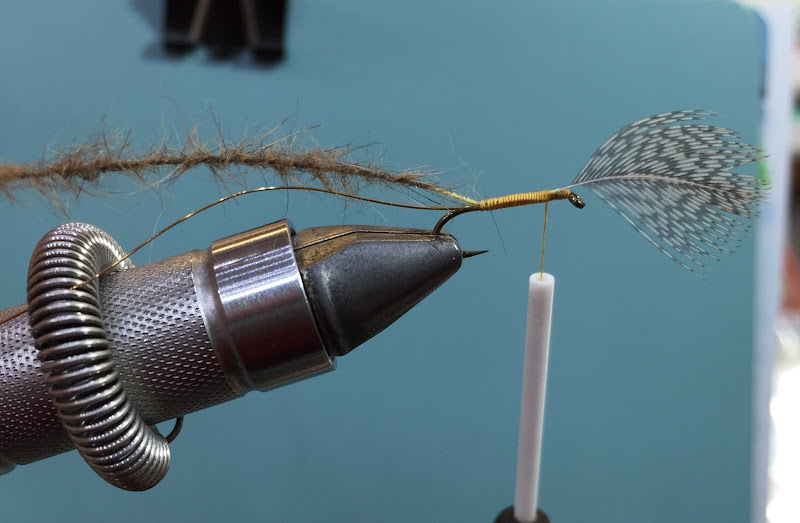Leisenring Spider (SBS/Tutorial)
Posted: Sun Feb 14, 2016 12:36 pm
This is the fly I tied for the 10 Year Anniversary IBF Swap.


Has anyone else taken the dust jacket off their copy of "The Art of Tying the Wet Fly"? Under the dust jacket, on the front cover of the book, is a cool embossed figure. I thought it made an interesting photo.
Sports Illustrated "Book of Wet-Fly Fishing", by Vernon S. (Pete) Hidy / 1960 / Page 74





PREPARATION OF SPUN BODIES - DUBBED BODIES ON WAXED SILK THREAD



For best results, prepare ahead of time and let them set for a day before using them to tye the flies. The wax will hold the dubbing in place better after it sits overnight.
LEISENRING SPIDER (as tyed for this swap)
Hook - Mustad Model 3906B (Size 14)
Thread - Pearsall's Gossamer Silk (Gold)
Hackle - Hungarian Partridge (Small Feathers From Neck Region)
Tag/Rib - Ultra Wire (Size Small/Gold)
Body - Silk Dubbing Brush (Natural Hares Ear Dubbing spun on Primrose Pearsall's Gossamer silk)
Dubbing Wax - Jim Slattery's Leisenring Wax (this wax has unbelievable grip! great stuff once you warm up a bit in your hand).
I used Jim Slattery's wax to form the dubbing brushes, and to treat the silk used for tying the fly. I broke my thread a couple times while tying the set of swap flies. I was amazed each time, with how the wax gripped the underlying materials and hook shank, preventing the fly from untwisting when the thread broke. I think this was a key advantages of the waxed thread. I must have been a huge help, before using a bobbin to hold your thread.
This photo shows my work process, when tying a large batch of flies. The materials are prepared and laid out in front of me. I count out the required number of hook (see magnet to the left), then prepare the hackle (unstripped hackle in the middle/ prepared hackle on the right). More magnets hold my hackle pliers and whip finisher within easy reach. The rest of my desk is a jumbled mess at the moment, but the area under and in front of the vice works nicely.

TYING INSTRUCTIONS
1) Mount hook in vice
2) Wax the tying silk and then secure the silk to the hook with five firm wraps just behind the eye of the hook.
3) Prepare a partridge feather by stripping off the basal fluff. Tye the feather in by the stem, with five wraps of thread.
4) Tye in a length of fine copper wire (in this case gold) and wrap back towards the bend of the hook. Stop just behind the point of the hook.
5) Wax roughly 6 inches of the tying thread. I like to keep the wax on the side of my index finger, while tying. The wax remains soft, and handy while tying.
6) Lift a prepared dubbing brush into place, under the last wrap of the tying silk and wrap tying silk forward to the front of the hook. Remember to leave a little room for the next steps. Don't crowd the eye.

7) Wrap the dubbing brush forward and secure with two wraps of thing thread.
8) Wrap the wire rib towards the bend of the hook, in three tightly touching turns. This will form a small wire tag at the back of the fly. Now wind the wire to the eye of the hook in roughly five open wraps, forming the rib. Secure with a couple wraps of well waxed tying silk. Wiggle ("helicopter" or "worry") the wire rib until it breaks off smoothly under the thread wraps.
9) Wind the hackle backwards towards the body of the fly, in two wraps. Secure the hackle by wrapping the tying silk forward thru the hackle, wiggling the thread back and forth as you go. Wiggling the thread helps prevent trapping of the hackle fibers. Once the hackle is secured, use the blade of you tying scissors to cut off the hackle tip.
10) Whip finish the head of the fly. In this case I intentionally formed a larger head, similar to the ones on Leisenring's flies.
Out of curiosity, I made a couple more of these flies by substituting fox squirrel dubbing, instead of the traditional hares ear dubbing. The fox squirrel dubbing is more spiky than the hares ear and it looks amazing against the primrose silk core.
Has anyone else taken the dust jacket off their copy of "The Art of Tying the Wet Fly"? Under the dust jacket, on the front cover of the book, is a cool embossed figure. I thought it made an interesting photo.
Sports Illustrated "Book of Wet-Fly Fishing", by Vernon S. (Pete) Hidy / 1960 / Page 74
PREPARATION OF SPUN BODIES - DUBBED BODIES ON WAXED SILK THREAD
For best results, prepare ahead of time and let them set for a day before using them to tye the flies. The wax will hold the dubbing in place better after it sits overnight.
LEISENRING SPIDER (as tyed for this swap)
Hook - Mustad Model 3906B (Size 14)
Thread - Pearsall's Gossamer Silk (Gold)
Hackle - Hungarian Partridge (Small Feathers From Neck Region)
Tag/Rib - Ultra Wire (Size Small/Gold)
Body - Silk Dubbing Brush (Natural Hares Ear Dubbing spun on Primrose Pearsall's Gossamer silk)
Dubbing Wax - Jim Slattery's Leisenring Wax (this wax has unbelievable grip! great stuff once you warm up a bit in your hand).
I used Jim Slattery's wax to form the dubbing brushes, and to treat the silk used for tying the fly. I broke my thread a couple times while tying the set of swap flies. I was amazed each time, with how the wax gripped the underlying materials and hook shank, preventing the fly from untwisting when the thread broke. I think this was a key advantages of the waxed thread. I must have been a huge help, before using a bobbin to hold your thread.
This photo shows my work process, when tying a large batch of flies. The materials are prepared and laid out in front of me. I count out the required number of hook (see magnet to the left), then prepare the hackle (unstripped hackle in the middle/ prepared hackle on the right). More magnets hold my hackle pliers and whip finisher within easy reach. The rest of my desk is a jumbled mess at the moment, but the area under and in front of the vice works nicely.
TYING INSTRUCTIONS
1) Mount hook in vice
2) Wax the tying silk and then secure the silk to the hook with five firm wraps just behind the eye of the hook.
3) Prepare a partridge feather by stripping off the basal fluff. Tye the feather in by the stem, with five wraps of thread.
4) Tye in a length of fine copper wire (in this case gold) and wrap back towards the bend of the hook. Stop just behind the point of the hook.
5) Wax roughly 6 inches of the tying thread. I like to keep the wax on the side of my index finger, while tying. The wax remains soft, and handy while tying.
6) Lift a prepared dubbing brush into place, under the last wrap of the tying silk and wrap tying silk forward to the front of the hook. Remember to leave a little room for the next steps. Don't crowd the eye.
7) Wrap the dubbing brush forward and secure with two wraps of thing thread.
8) Wrap the wire rib towards the bend of the hook, in three tightly touching turns. This will form a small wire tag at the back of the fly. Now wind the wire to the eye of the hook in roughly five open wraps, forming the rib. Secure with a couple wraps of well waxed tying silk. Wiggle ("helicopter" or "worry") the wire rib until it breaks off smoothly under the thread wraps.
9) Wind the hackle backwards towards the body of the fly, in two wraps. Secure the hackle by wrapping the tying silk forward thru the hackle, wiggling the thread back and forth as you go. Wiggling the thread helps prevent trapping of the hackle fibers. Once the hackle is secured, use the blade of you tying scissors to cut off the hackle tip.
10) Whip finish the head of the fly. In this case I intentionally formed a larger head, similar to the ones on Leisenring's flies.
Out of curiosity, I made a couple more of these flies by substituting fox squirrel dubbing, instead of the traditional hares ear dubbing. The fox squirrel dubbing is more spiky than the hares ear and it looks amazing against the primrose silk core.